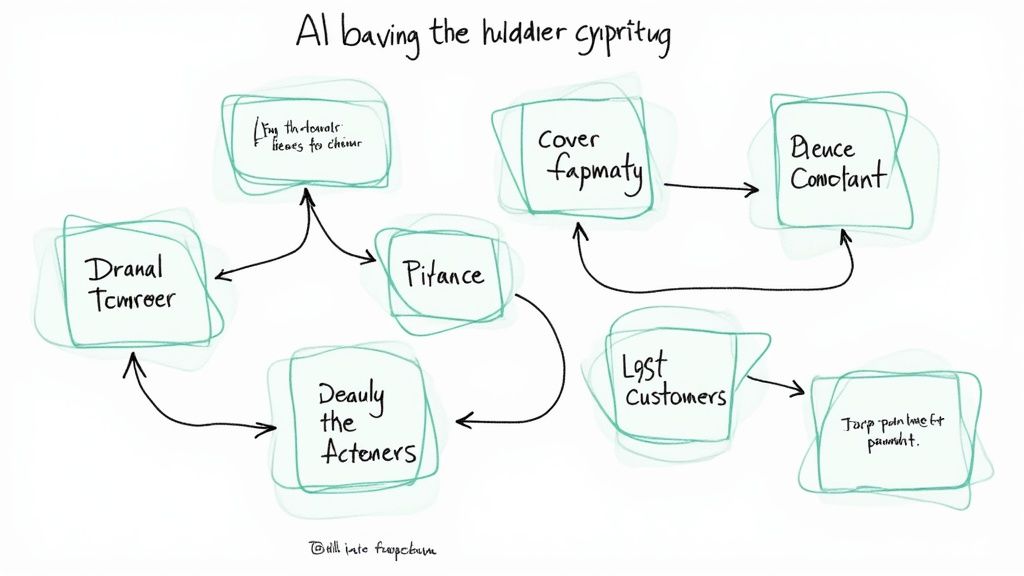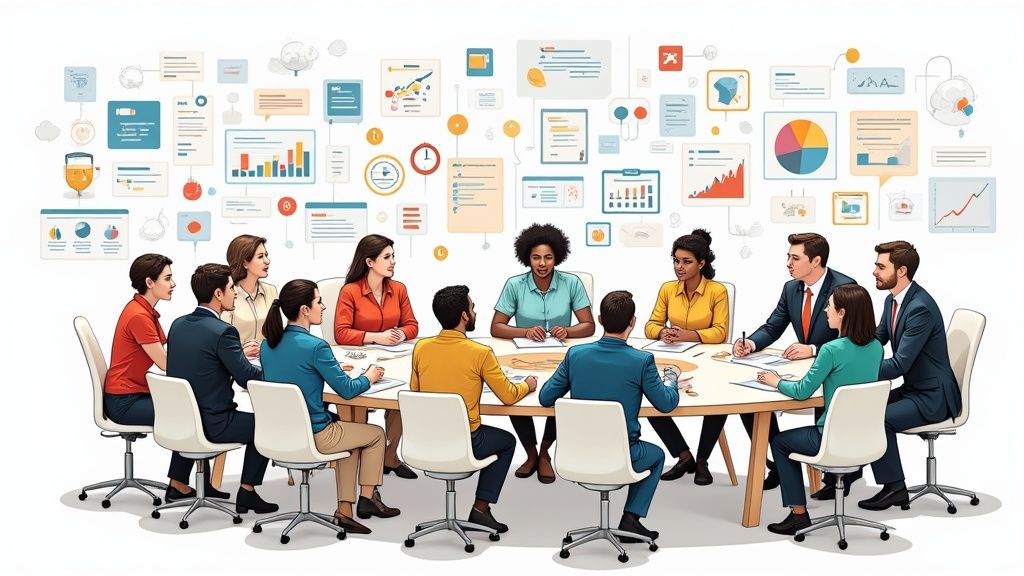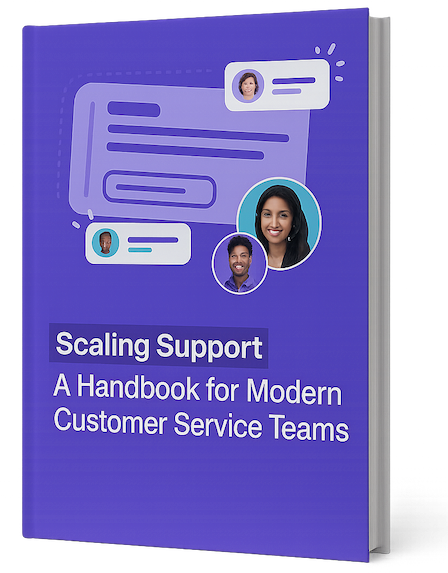Customer service training is much more than a business requirement – it’s a vital investment that directly impacts your company’s growth and success. The effects ripple through every aspect of business performance, from revenue numbers to how well you retain customers. When companies commit to structured training programs, they often see clear improvements in their key metrics, showing just how essential good training is for business success.
Why Traditional Training Falls Short
Old-school customer service training methods like memorizing scripts and generic role-playing exercises simply don’t work well anymore. These approaches fail to prepare agents for the complex, nuanced conversations they face with today’s customers. Most importantly, rigid scripts and scenarios make it hard for agents to build real connections and adapt their approach based on each customer’s unique situation. This inflexible training style often leaves customers feeling like they’re talking to robots rather than empathetic humans who understand their needs.
Reimagining Service Training for Lasting Impact
Leading companies are moving beyond outdated training methods to create more dynamic learning experiences. They recognize that agents need practical skills for building rapport, handling difficult situations, and consistently delivering excellent service. Some organizations now include real-time coaching and feedback in their programs, allowing agents to improve their abilities through hands-on practice. This shift toward applied learning helps bridge the gap between training concepts and real-world customer interactions.
Measuring the ROI of Training Investments
To understand if your training truly works, you need clear metrics. Key performance indicators like customer satisfaction scores, issue resolution rates, and customer retention provide concrete evidence of training effectiveness. For instance, companies often see their customer satisfaction scores climb significantly after implementing strong training programs. By tracking specific metrics like first response times and resolution speed, you can quantify exactly how training improves your team’s performance and efficiency.
Building Executive Buy-In for Training
Getting leadership support for training initiatives requires showing clear business impact. When you can demonstrate how training directly improves revenue, customer loyalty and other key metrics, executives are more likely to provide needed resources and backing. Focus on presenting training as a strategic investment that drives long-term growth rather than just another expense. Show how a well-trained service team gives you an edge over competitors by consistently delivering experiences that keep customers coming back. Real performance data helps make this case compelling.
Crafting Training That Actually Sticks
Effective customer service training requires moving beyond basic memorization and roleplaying exercises. These traditional methods often fail to prepare agents for the complex, nuanced interactions they face daily with customers. To create lasting impact, companies need to rethink how they structure their training programs.
Designing Dynamic Learning Experiences
The most effective training focuses on real-world application rather than theory. Instead of having agents memorize scripts, programs should emphasize active listening, empathy, and flexible communication that adapts to each customer’s needs. This helps agents build authentic connections and solve problems more effectively. The training should include plenty of hands-on practice through interactive exercises and case studies. Much like learning to ride a bike requires getting on and practicing, customer service skills must be developed through repeated real-world practice handling different scenarios.
Aligning Training With the Customer Journey
Top performing customer service teams ensure their training directly connects to actual customer experiences. Yet research shows only 19% of teams currently align their training content with real customer interactions. This presents a major opportunity for companies to gain an edge. By mapping training to specific touchpoints in the customer journey – from first contact through ongoing support – agents can be properly prepared for the exact situations they’ll encounter. This targeted approach helps them confidently handle any customer interaction.
Balancing Immediate Needs With Long-Term Development
Strong training programs address both pressing daily challenges and ongoing professional growth. This requires combining practical training on current support issues with opportunities to build advanced skills over time. Training might include specific modules on support tools and common problems, alongside deeper workshops on communication techniques and handling difficult conversations. This comprehensive approach equips agents for both immediate needs and future challenges.
Maintaining Engagement and Motivation
Keeping agents engaged throughout training is essential for success. Programs can incorporate game elements, provide regular constructive feedback, and create a supportive learning environment. Like an effective coach, training should inspire agents to continuously improve their skills. When companies foster ongoing learning and development, they build highly capable teams that consistently deliver great customer experiences. This focus on engagement improves both skill retention and morale, benefiting agents and customers alike.
Measuring What Matters in Training Success

Getting the most value from your customer service training requires smart measurement. While tracking basic metrics like attendance is important, the real insights come from analyzing how training impacts day-to-day performance and results. The key is identifying and monitoring the metrics that show whether your programs are actually improving customer service delivery.
Key Performance Indicators (KPIs) for Customer Service Training
The right KPIs help you understand if your training is working. Beyond surface-level numbers, effective KPIs reveal how well agents apply what they learn and whether it benefits customers. Here are essential metrics to track:
- Customer Satisfaction (CSAT): Regular surveys and feedback forms show if customers are having better experiences after training programs. Rising CSAT scores often indicate successful training.
- First Response Time (FRT): Track how quickly agents respond to customers. Faster response times suggest agents are more confident and efficient after training.
- Resolution Rate: Monitor how often issues get solved in one interaction. When agents solve more problems the first time, it shows training has equipped them with needed skills.
- Customer Churn Rate: Keep tabs on customer retention. Lower churn often means better service experiences from well-trained agents.
- Operational Efficiency: Look at metrics like average handle time and support costs. Companies with strong training programs typically see support costs drop by 7% annually.
Building a Performance Dashboard
A well-designed dashboard brings KPIs together to paint the full picture. Your dashboard should make it easy to spot trends and patterns, like whether faster response times lead to higher satisfaction. This helps identify what’s working and what needs adjustment. It also helps you show company leaders the concrete value of investing in training.
Gathering Meaningful Feedback
Numbers tell part of the story, but direct feedback from agents and customers adds crucial context. Ask agents which parts of training help most in their daily work. Survey customers about their recent support experiences. This two-way feedback loop points to specific ways to improve your programs. The goal is understanding if agents feel ready to use what they learned and if customers notice better service.
Data-Driven Improvements
Use both KPI data and feedback to keep refining your training. You might find agents excel at product knowledge but need more help with communication skills. Regular analysis ensures your programs evolve with changing customer needs and expectations. This focused, data-backed approach helps you invest training resources where they’ll have the biggest impact.
Transforming Service Teams Into Revenue Drivers
Customer service teams can do much more than just solve problems – they can actively drive revenue growth. This requires a strategic training approach that empowers agents to excel at both service and sales opportunities.
Educating for Engagement and Increased Sales
When customers receive helpful education during support interactions, they become 131% more likely to make purchases. That’s why modern customer service training needs to go beyond basic troubleshooting skills. Agents should learn in-depth product knowledge, competitive differentiators, and techniques for understanding customer needs. This enables them to naturally position relevant solutions that benefit customers.
Soft Skills: The Key to Upselling and Trust
To successfully offer additional products and services, agents need strong interpersonal abilities. Customer service training programs should focus on essential soft skills like:
- Active Listening: Understanding the full scope of customer needs and concerns
- Empathy: Building genuine connections that establish trust
- Clear Communication: Explaining product value and benefits in simple, compelling terms
- Handling Objections: Addressing concerns professionally while keeping the conversation positive
This skills-based approach helps agents become trusted advisors rather than aggressive salespeople, leading to lasting customer relationships.
Striking the Right Balance: Service and Sales
The key is maintaining excellent service standards while pursuing sales opportunities. Customers should never feel pressured or that their support needs take a backseat to sales goals. Training must emphasize authentic conversations focused on finding solutions that truly match customer needs. Agents should only suggest upgrades, add-ons or premium services when they genuinely benefit the customer.
Measuring the Impact of Training on Revenue
Track specific metrics to gauge how training affects revenue, including:
| Metric | Description |
|---|---|
| Upsell/Cross-sell Conversion Rate | Percentage of service interactions that result in an additional sale |
| Average Order Value | The average amount spent per customer transaction, potentially increased through successful upselling |
| Customer Lifetime Value | The total revenue generated from a customer over their relationship with the company, boosted by ongoing engagement and upselling |
By monitoring these key indicators, companies can see the direct impact of training investments and refine programs to optimize revenue generation. With the right training approach, service teams become growth engines that boost both customer satisfaction and business results.
Building Cross-Functional Training Success

The best customer service training programs bring your entire organization together. By breaking down barriers between departments and fostering collaboration, these programs ensure everyone – from product teams to marketers – understands how their work impacts customers. When done well, cross-functional training leads to measurable improvements in key metrics and helps build a culture where customer needs come first.
Aligning Customer Service Training With Business Objectives
For training to drive real results, it must connect directly to your company’s goals. This means designing programs that help different teams work together more effectively. For instance, when customer service agents share feedback from support conversations with product developers, it often leads to better product features. Similarly, when service training aligns with marketing plans, customers get consistent messaging at every touchpoint.
Fostering Collaboration Through Cross-Functional Training
Getting teams to collaborate starts with shared learning experiences. Joint training sessions where people from different departments tackle customer service scenarios together help build understanding between teams. When support agents spend time shadowing other departments, they gain valuable first-hand insights into how different parts of the business operate. This leads to better communication and problem-solving across the organization.
Creating Consistent Customer Experiences
When everyone understands the customer journey, it shows in every interaction. Cross-functional training helps create a unified approach to customer service that builds trust and loyalty over time. This matters because research shows 71% of consumers make buying choices based on the quality of support they receive. Consistent service quality, regardless of which team member they talk to, keeps customers coming back.
Developing Cross-Functional Training Initiatives
To build an effective cross-team training program, follow these key steps:
- Needs Assessment: Figure out what skills and knowledge different departments need to serve customers better.
- Objective Setting: Create clear, measurable goals that support both service quality and broader business targets.
- Curriculum Development: Build engaging training content using real examples relevant to each department. Mix different learning methods like workshops, online modules and hands-on practice.
- Implementation and Evaluation: Launch the program and track its impact regularly. Get participant feedback and measure key metrics to see how training affects customer satisfaction, efficiency and revenue. Companies with strong training often reduce support costs by 7% each year.
This structured approach helps break down silos between teams while improving how the entire organization serves customers. Rather than leaving customer service to one department, it becomes everyone’s priority – leading to happier customers and better business results.
Adapting Training for Tomorrow’s Challenges

As technology and service expectations continue to advance, customer service teams need training that keeps pace with these changes. Forward-thinking organizations are moving beyond traditional training methods to build flexible programs that maintain high service standards while adapting to new demands.
Embracing Emerging Technologies in Training
Customers now interact with businesses through Intercom, AI assistants, and personalized digital channels. This shift means support teams must learn to work seamlessly with these tools. Agents need training on collaborating with AI systems, understanding where automation can help (and where it can’t), and using data to create more personal customer experiences. Static training modules are giving way to hands-on practice with the actual tools teams use daily.
Navigating the Changing Landscape of Customer Service
Social media platforms, community forums, and self-service options have become go-to channels for customer support. Modern training programs must prepare agents to assist customers across these different spaces effectively. Focus areas now include writing clear and helpful online responses, following digital etiquette best practices, and solving problems remotely. The goal is helping agents build skills that work well in both traditional and digital support environments.
Innovative Learning Approaches for the Future
Standard classroom training often falls short in preparing teams for today’s complex support scenarios. New methods like bite-sized learning modules, game-based training, and practice simulations are proving more effective. Short, focused lessons let agents learn at their own speed while reinforcing key concepts. Adding competitive elements and rewards makes training more engaging. Virtual simulations give agents safe spaces to practice handling real situations before working with actual customers.
Building Adaptable Training Frameworks
Creating training that evolves with customer needs requires a flexible foundation. This means building programs in modules that can be updated easily as tools, processes and expectations change. Taking a continuous learning approach, rather than one-time training, helps teams stay current. Regular reviews ensure training materials remain relevant and that agents have the right skills to deliver excellent service. Making training adaptable this way lets organizations respond quickly to changes while maintaining consistent quality standards.
Ready to empower your customer service team with a tool that fosters continuous improvement and elevates customer satisfaction? Try SupportMan, a platform that integrates Intercom ratings directly into Slack, enabling real-time feedback and data-driven improvements. Start your free trial today at https://supportman.io.


